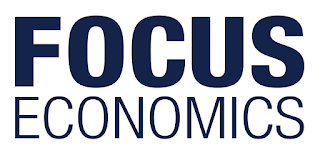A second GDP estimate confirmed that the economy ran out of steam in the first quarter, amid a broad-based deceleration. Wholesale and retail trade contracted in Q1 as January’s VAT hike dented consumer demand, while a lackluster outturn in the manufacturing and constructions sectors further derailed growth. Moreover, constrained oil output and weak energy demand from Europe curbed mining activity, bringing merchandise exports to a near halt in Q1. Turning to Q2, soft momentum appears to have persisted. After rebounding in April, economic activity growth tumbled again in May, owing to a deterioration in the manufacturing sector. In addition, weaker household consumption likely played a role, as retail sales growth slid in the month. Going into Q3, the focus is on 1–2 July OPEC+ meeting, where oil output cuts are likely to be extended.
Sliding private consumption and a downbeat external sector will restraint growth this year, although an uptick in public spending should provide some relief. Meanwhile, growth in the short-term should pick up slightly thanks to monetary policy easing, while a stronger boost over the medium-term is expected as the “national projects” plan gains traction. FocusEconomics panelists see growth at 1.4% in 2019, which is unchanged from last month’s forecast. In 2020, GDP is seen increasing 1.8%.
Inflation ticked down to 5.1% in May (April: 5.2%), inching slightly closer to the Central Bank’s 4.0% target. Nevertheless, price pressures remained elevated following from January’s VAT hike and due to rapidly rising food prices. Inflation should ease going forward, supported by a stable ruble and soft consumer demand. Inflation is seen ending 2019 at 4.4% and 2020 at 3.9%.
On 14 June, the Central Bank trimmed its key interest rate by 25 basis points to 7.50%. The decision marked the first rate cut since March 2018 and came against the backdrop of gradually moderating inflation and slower-than-expected economic growth. The Bank’s relatively dovish tone signals that further policy easing is likely in the second half of the year. Accordingly, the majority of our panelists see the Bank cutting the rate by another 25 basis points by the end of the year. Consensus projects it to end 2019 at 7.13%. In 2020, the key rate is expected to end the year at 6.69%.
The ruble gained ground in recent weeks, strengthening to a 10-month high in mid-June, partly thanks to a strong demand for treasury bonds. Nevertheless, reduced hopes of a Fed rate cut curbed the currency’s gains. On 28 June, the RUB traded at 63.0 per USD, appreciating 2.2% month-on-month. Our analysts expect the ruble to largely stand its ground in the coming quarters. Our panel sees the ruble ending 2019 at 65.6 per USD and 2020 at 66.6 per USD.
REAL SECTOR -> Growth plummets in Q1 on broad-based frailties...
GDP growth plunged to 0.5% year-on-year in the first quarter of 2019, according to a second estimate released by Rosstat. This was notably below Q4’s 2.7% outturn and matched the preliminary figure. A breakdown by sectors revealed broad-based weakness across the economy. Notably, the wholesale and retail trade sector contracted 3.0% in annual terms, weighed on by the hike in the VAT that was introduced in January. In addition, the agricultural sector swung to contraction, declining 1.2% annually in Q1 (Q4: +2.3% year-on-year), while growth in the manufacturing sector picked up pace but remained muted (Q1: +0.6% yoy; Q4: +0.2% yoy). The construction sector also ground to a halt, recording zero growth after several major infrastructure projects were completed in 2018, while the government’s ‘National Projects’ program is off to a slow start. Meanwhile, growth in the mining sector was relatively robust, clocking in at 4.6% in Q1, but was well below Q4’s multi-year high of 7.7% nonetheless.
OUTLOOK -> Economic conditions deteriorate in May
The manufacturing Purchasing Managers’ Index (PMI) produced by IHS Markit
dropped from 51.8 in April to 49.8 in May, marking a nine-month low. As a
result, the index lies below the critical 50-point mark and points to contracting
activity in the manufacturing sector. May’s result reflected a notable drop in
employment, with firms shedding jobs at the fastest pace since March 2016.
In addition, new orders and output also lost steam.
The services sector also lost momentum in May, with the IHS Markit Russia
Services Business Activity index falling to 52.0 from April’s 52.6. Firms
reported a modest rise in new business and services providers shed jobs for
the first time since September. FocusEconomics Consensus Forecast panelists project fixed investment will expand 1.9% in 2019, which is down 0.1 percentage points from last month’s forecast. In 2020, the panel expects fixed investment to grow 2.3%.



